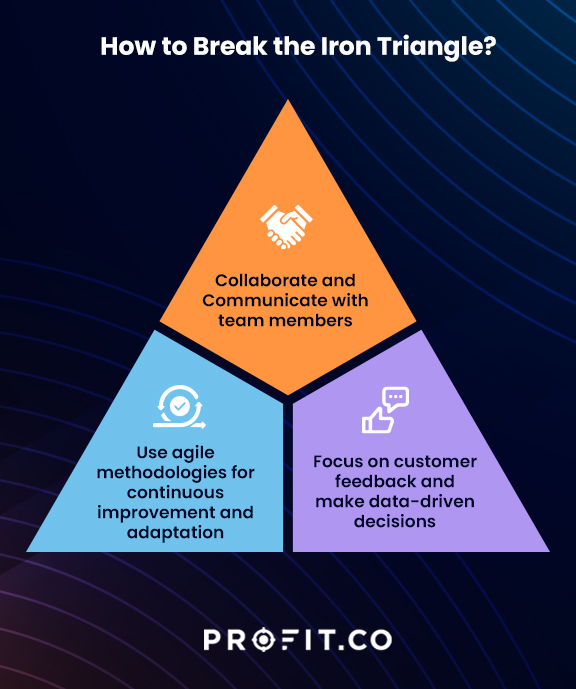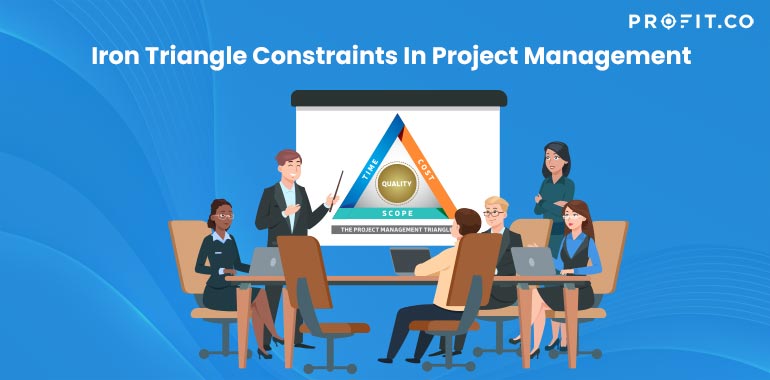Introduction
Do you ever feel overwhelmed when managing a project, wondering if you should prioritize speed, cost, or quality? If it’s a yes! then it can seem like an impossible trade-off. This is a typical Iron triangle example. This project planning tool can help us to speed up the course of action.
This article will explore the emphasis of the Iron Triangle in the field of project management, its representation, and how the triple constraints can manifest in project management, followed by the discussion of the applications of both traditional and agile methodology to break the constraints of Iron Triangle to ensure successful projects.
Let’s get started!
What is the Iron Triangle?
The Iron Triangle is an agile concept in project management that describes the three core fundamental elements of any successful project: Speed or Time, Cost, and Quality.
As per the iron triangle definition, for projects to be successful, all three aspects must remain balanced. If one of the aspects increases, the other two need to decrease for the project to stay on track.
For example, increasing costs will mean slower progress and lower quality results; unless you bring in additional resources or compromise other project areas.
According to Dr. Martin Barnes, who proposed the original iron triangle in 1969, the iron triangle’s constraints are “iron” since it’s impossible to adjust one limitation without affecting the others.
The triangle comes after a waterfall approach in product development. The scope remains fixed, but the time and resources are variable.
The iron triangle software development approach requires you to begin the project by specifying the product requirements. Once the conditions are clear, it’s easy to define the project’s scope.
Since the schedule and resources are variable, you can estimate them based on the fixed scope.
What Does It Represent?
The Iron Triangle represents the three core elements of any successful project: speed, cost, and quality. It serves as a reminder that managing these key components are essential for maintaining progress throughout each stage of a project’s life cycle.
It is important to remember that all three pieces must harmoniously come together to achieve the overall project goals and objectives.
Effective leadership is putting first things first. Effective management is discipline, carrying it out.
Iron Triangle
Though the iron triangle is not visibly encountered in a project, we still would have come across these three core components to remain balanced for a successful outcome and we must carefully manage these three pieces throughout every stage of a project’s life cycle.
Cost savings or faster delivery times should never come at the expense of quality. Instead, all these three aspects should work together in a balanced fashion to achieve success.
Applying the Iron Triangle in Project Management
Applying the Iron Triangle in project management is essential for delivering successful projects.
By balancing the core components throughout the project, you can address all aspects equally. This will help reduce costs while ensuring high-quality results and faster delivery times.
With careful planning and effective communication between team members, it’s possible to ensure everyone understands their roles within this system to achieve success. Project management can be more effective with better outcomes by using the OKR methodology. Using this goal management platform, goals can be broken down into measurable key results that can be tracked for better execution. Book a free demo with our team to learn more about how OKR software can optimize your organization’s performance!
Iron Triangle and Agile
The iron triangle aims to empower teams with the essential information to decide on trade-offs that benefit the business. For instance, if the team has a fixed scope, they may realize that it’s impossible to meet the release date in the middle of the project.
They can only work with two variables:
-
Time – The team can adjust the release date
-
Resources – You can onboard more people to work on the project, which will affect the costs
As project management evolved, it became evident that it’s crucial to respond swiftly to client feedback and collaborate better. This need motivated the development of the agile methodology.
Agile methodology is a popular project management method focusing on delivering value quickly and efficiently. It emphasizes collaboration, adaptation, and continuous improvement over traditional planning and delivery methods.
The Iron Triangle is a critical concept to understand when applying the agile methodology. It helps ensure the three main elements of any successful project remain balanced for maximum efficiency.
Agile project management can help break down the constraints of the Iron Triangle. It allows teams to be more creative with their approach to problem-solving. It also ensures that all components remain in balance throughout each stage of the project life-cycle.

How to Break the Iron Triangle
Breaking the Iron Triangle can be tricky since all three elements must have a balance for a successful outcome.
The secret is to focus on collaboration and communication between team members. You must also understand the core components that make up each element.
For example, when it comes to speed, you should optimize your processes and procedures to get things done faster. There’s no need to sacrifice quality or incur additional costs.
You should use agile methodology or techniques such as continuous improvement and adaptation regarding cost. It will help reduce waste while delivering quality results within budget guidelines.
Finally, you need to focus on customer feedback and data-driven decision-making regarding quality. It ensures you’re meeting customer needs without compromising either speed or cost.
By considering these steps throughout every stage of the project life-cycle, you can break down the constraints of the Iron Triangle to achieve success without sacrificing any aspect over another.
FAQs
- What is the Iron Triangle in project management?
The Iron Triangle is a concept used to represent the three interconnected constraints of project management – time, cost, and scope. It is essential to carefully manage these components throughout every project’s life cycle to ensure successful outcomes.
- How do you break the Iron Triangle?
Breaking the Iron Triangle can be tricky since all three elements must balance for a successful outcome. Focus on collaboration and communication between team members and understand the core components of each element. Earned Value Management (EVM) can also help optimize resources while still completing quality work on schedule.
- What are some ways to apply the Iron Triangle when using agile methodology?
Agile methodology is a popular project management method focusing on delivering value quickly and efficiently. When applying the agile methodology, you should optimize your processes and procedures to work faster without affecting the costs and quality.
Conclusion
The Iron Triangle is essential to understand when managing successful projects. It serves as a reminder that you must balance speed, cost, and quality for maximum efficiency and success.
Agile methodology can help break down the constraints of the Iron Triangle. It allows teams to be more creative with their approach to problem-solving. It also ensures that all components remain in balance throughout each stage of the project life-cycle.
Proper management of these three elements ensures that projects remain on track. You can deliver high-quality results at a reasonable cost and promptly.
For more agile methodologies to execute your projects, you can get started on Profit.co completely free today! Our OKR software is a goal management platform that allows you to manage your strategy.

